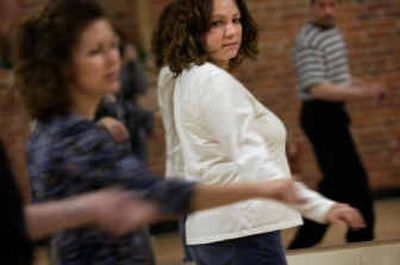Eleanor Folsom: Stay-at-home mom now has more energy

It’s not like Eleanor Folsom is one of those women who can’t say “No.”
She has a track record. When demands on her time seem to be spiraling out of control, she makes choices. (That’s how swimming and soccer got bumped from the family schedule last winter.)
But not long ago, she realized something wasn’t working. So the 30-year-old stay-at-home mother of three made a list.
“I would just like to organize my life in a way that I can:
“1. Be there for my children and be a fun mom.
“2. Start our new construction business.
“3. Organize myself better with paperwork for our investment properties.
“4. Find time to be myself and enjoy personal time.”
Enter life coach Susie Weller.
When the two meet in person for the first time at Folsom’s Spokane Valley home, Weller does a lot of listening.
She hears about a woman accustomed to doing things for her kids, her hard-working husband and her church but seldom for herself.
Weller suggests that it wouldn’t be selfish for Eleanor to tweak that. “The more you’re not running on empty, the more you have to give,” she says.
This proves to be the nudge Folsom needs to sign up for weekly ballroom dance classes. All soon agree that decision proved to be a good one. Recreation can be re-creation, as they say.
But initially Folsom is skeptical about the apparent direction of the coaching. She craves concrete time-management tips. And Weller is talking about spiritual wellness and listening to her body. “It seems Susie wants to focus more on me as an individual and making me ‘happy and fulfilled,’ ” she confides.
In the ensuing weeks, the two women talk by phone about Eleanor’s feelings of guilt over not getting more done each day and about just what constitutes reasonable self-expectations.
Folsom becomes a convert. She acknowledges that the coaching has helped her understand what’s really required to change habits.
“I usually have to schedule my ‘me’ time, but so far it has been working,” she says.
She has more energy. She feels more focused.
When the two women meet again, five weeks after the initial get-together, Eleanor beams and reports that working with Susie has reminded her of something: “Hey, you know, I’m a person, too.”
Weller’s questioning and gentle prodding have helped Folsom scrutinize how she makes choices.
At the beginning, Weller had gotten Folsom to fill out a life satisfaction assessment. In the category of “Ability to make progress on goals and create the life you want,” Eleanor had given herself a “5.”
Weeks later, she takes the survey again and raises her score to a “9.”
As the women are about to say their goodbyes, the conversation turns to how to talk to others who are feeling stretched and rudderless. The coached now sounds like the coach.
Says Folsom, “The first thing I would ask is, ‘What are you doing for yourself?’ “